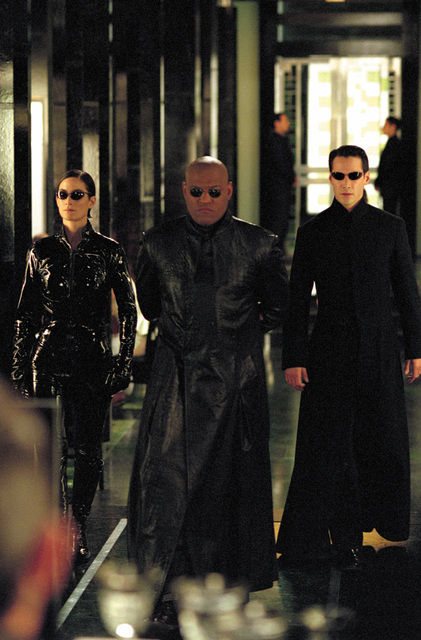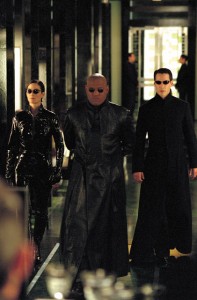
 Archival interview with Allison Gibbons from the official Matrix website.
Archival interview with Allison Gibbons from the official Matrix website.
MATRIX: Could you explain what an Assistant Editor’s duties are?
ALLISON: When we get our camera rolls from the lab we check them against our breakdown that lets us know which slate goes where — sometimes you get camera rolls containing different scenes and they need to go on different dailies rolls. I break the film apart into the slates, which generally leaves us with lots of little bits and pieces, and then we build them up into rolls that Catherine [Chase, 1st Assistant Editor (Film)] has sorted into a screening order that she goes through every morning.
MATRIX: As I understand it, not everything that is shot is shown at dailies.
ALLISON: No, it’s not.
MATRIX: Are the shots you assemble what is shown at dailies?
ALLISON: Sometimes. We have selects and non-selects that need to be gone through eventually as well, so I might pull out one slate and the other four are put on a different roll that still goes into the system but are slates that the brothers don’t want to see but still can be used in the film.
MATRIX: How did you become an Apprentice Editor?
ALLISON: I was a projectionist on the first MATRIX and they needed some help in the cutting room towards the end of filming, so I was sort of thrown in the deep end.
MATRIX: What equipment do you use?
ALLISON: My synchronizer has all the frames on it – there are four sprockets to a frame – and using the synchronizer I can then mark a sequence at any frame. When you make a cut you want to cut it in rack because if you cut it in a sprocket short you’ll see the frame line when it’s being shown. To make the cuts I use a splicer; I just put the film on it and then I cut it. Splicing tape will join it back together again; it’s got the same kind of sprocket holes in it. You just line it up on the splicer, tape it on both sides, and off you go.
MATRIX: Do you still project the dailies?
ALLISON: No, I take them up to the projectionist and tell her what order they go in, what has sound, what is mute, and then I get to push the button and go, “ready to roll.” It’s all very exciting, I still go to the dailies every night.
MATRIX: What is your role while you’re there?
ALLISON: Basically just to take the film up to the projectionist before the Brothers arrive and to make sure it looks presentable. I test it to make sure all the sound is working, and have a look at the picture to make sure there are no hairs in the projector and that the image looks right. When they come I sit next to the microphone so I can talk to the projectionist so if they want to roll through the focus I can let her know. Then I get the film and take it to telecine afterwards.
MATRIX: Have you ever had any big drama where the sound didn’t sync?
ALLISON: That’s all checked here on the Steinbeck [a device for editing film] before we actually go up. Sometimes there are some technical difficulties but usually it can be sorted out. Sometimes machines just don’t want to cooperate.
MATRIX: Are there other duties you’re responsible for?
ALLISON: It depends. Today is a pretty light day, but if we’re really busy I can be sitting here breaking film apart until after lunch. Once it’s all compiled we check it to make sure it’s all in a screening order, and then log it by the barcodes that run along the side of the film. We have a special barcode reader that picks up those little barcodes so when we log it we know the start of each slate from where the barcode is.
Once it’s all logged, Dave [David Birrell, AVID Assistant Editor] syncs up the rushes, it’s checked, and then we get it out to the numbering machine where we mark it again, placing rubber numbers on it for each scene. Every foot of film needs to be numbered, so later, when they’re in post-production, they can cut the film by those numbers. The numbering machine is not the fastest, so that takes a little while. Then the footage is placed in boxes and we take it up to rushes and there we go. Then we do it all again the next morning.
MATRIX: What has been your biggest challenge so far on this production?
ALLISON: It would probably just be the hours. Sometimes we get a lot of film and it’s just really hard, but we seem to get there every day. That’s probably been the toughest — day in, day out, more film, more film.
MATRIX: What would you say your hours are like?
ALLISON: About thirteen or fourteen hours a day, depending on overtime, but I try to stick to twelve. It all depends on when they wrap and when they get up to rushes.
MATRIX: Generally how many minutes do you show every day in dailies?
ALLISON: It depends what the Brothers have selected, but we probably haven’t sat through longer than sixty minutes at a time. And if they skip a night then we’ve got double dailies the next night, but lately it’s been about half an hour’s worth. That’s the three units — main, second, and third. It’s quite nice to see all this work you put in during the day projected that night.
MATRIX: Thank you so much, Allison.
Interview by REDPILL
August 2002

Be the first to comment